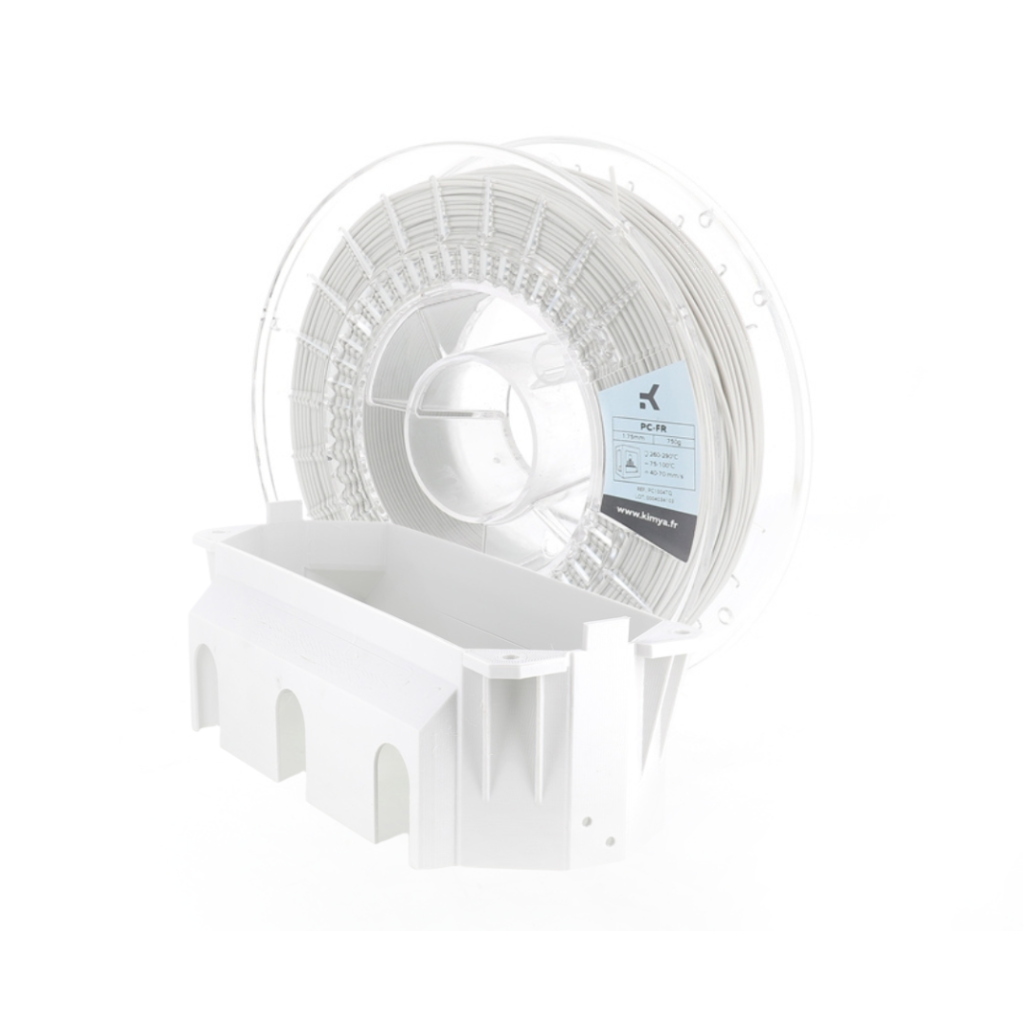Kimya, the additive manufacturing materials arm of technology company ARMOR, launched a new high-performance 3D filament named Kimya PC-FR.
This novel filament is intended for use in the transport industry. Kimya PC-FR is a ready-to-use fire-smoke polycarbonate plastic with a melting point of 105ºC. Kimya PC FR filament is accredited to EN45545-2 levels HL1/HL2/HL3/R1 and R6, making it particularly appealing for applications requiring fire safety, such as mass transportation (rail, aviation, and naval).
“Due to its specific technical characteristics, Kimya PC-FR is an ideal material for printing mechanisms and railway parts that are subject to high heat, such as runners to increase the wheel-rail adhesion of a train during emergency braking”, said Nicolas Morand, R&D, Innovation and Industrialization Manager at KIMYA.

KIMYA’s industrial portfolio
KIMYA revealed plans to expand its recycled filament range to include novel high-performance materials By 2024. Future high-performance filaments will contain between 70 and 100 percent recycled materials, without modifying their properties, as part of KIMYA’s third stage of ARMOR’s FIL’REC project, which is connected to the ORPLAST plastics recycling program.
Furthermore, Kimya also provided 3D printing services to the railway industry. An unidentified railway provider needed a protective cover component created in 1982 and turned to Kimya to 3D print a small batch of the polymer part using the Kimya Factory manufacturing service. Because the mold for the cover no longer existed, the spare parts had to be reshaped from the ground up before production. The team was able to produce the 3D printed protective covers with cost savings and shorter lead times by employing a PEKK filament created in-house at the company’s R&D center, Kimya Lab.
“In order to address our industrial clients’ needs as closely as possible, we continue to enrich our range of high-performance filaments created in our own R&D department. Thanks to our expertise in chemical formulation, we can create bespoke materials very quickly and ready-to-use products for any type of application, including food contact and Outdoor environments, including industrial sector applications subject to solvents or high temperatures,” said Benoît Stoeux, Managing director at KIMYA.
Furthermore, KIMYA has formed numerous alliances with 3D printer manufacturers to make the printing process easier for all users. The goal is to get Kimya filaments approved for use on their machines, for industrial customers, and for professional office services. For instance, the Kimya PC-FR filament has been approved for use on the Ultra model by miniFactory, a KIMYA partner since 2018.
“The leading manufacturers of 3D printers recognize our expertise in the formulation and production of high-performance filaments. In 2022, two of our materials were approved by Stratasys allowing users to benefit from an extended filament range, gain flexibility and accelerate the adoption of additive manufacturing to their production process. In parallel, we are also capable of developing bespoke materials for our manufacturing partners,” added the Managing director at KIMYA.

Additive manufacturing sector’s material portfolio
Recently, additive manufacturing company Inkbit, introduced Titan Tough Epoxy 85, the latest additive manufacturing material in its portfolio at Formnext 2022. This material, which has been designed especially for sturdiness, improves performance for applications that necessitate high precision as well as production-grade mechanical properties. This material was developed in response to consumer demands for parts that are tough, accurate, and designed for AM, which typically means intricate geometries.
Furthermore, Mimaki, a manufacturer of wide-format inkjet printers and cutters, showcased its recent 3D printing innovations at Formnext 2022. The company used its existing portfolio to implement its newest Mimaki 3DUJ-2207 system to 3D print parts live at the show for visitors to see in real time. Mimaki also introduced Pure Clear MH-110PCL, a transparent material designed to be mixed with users’ preferred color to form a transparent feedstock ideal for medical and architectural 3D printing applications.
Elsewhere, Dressler Group (DG), a manufacturer of thermoplastic powders, displayed its capacity to enhance quality and efficiency for its clients while also serving as its personal driver of innovation at Formnext 2022. According to the company, it is dedicated to maximizing its raw materials and resources in all processes, whether developing individual powder solutions for customers or its own manufacturing plants and processes.
“With our new ‘grind your own powder’ approach, we guarantee our US customers that they will be able to produce any powder we have developed together in Meckenheim on their own premises in the future, using a DG plant configured especially for them. Just in time, in precisely the required quantity and, most importantly, in the accustomed Dressler quality every time,” said Jan Dressler, CEO of Dressler Group.
Follow this link for all the Formnext 2022 news.
To stay up to date with the latest 3D printing news, don’t forget to subscribe to the 3D Printing Industry newsletter or follow us on Twitter, or like our page on Facebook.
While you’re here, why not subscribe to our Youtube channel? Featuring discussion, debriefs, video shorts, and webinar replays.
Are you looking for a job in the additive manufacturing industry? Visit 3D Printing Jobs for a selection of roles in the industry.
Feature image shows KIMYA developing new high-performance materials from recycled plastic for the third stage of the ORPLAST scheme. Photo via KIMYA.



